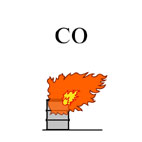| Case Name |
Leakage and fire of carbon monoxide caused due to breakage of a gas expander from over revolutions at a fluidized catalytic cracker unit |
| Pictograph |

|
| Date |
February 25, 1994 |
| Place |
Kawasaki, Kanagawa, Japan |
| Location |
Refinery |
| Overview |
The pressure control valve at the power recovery system of a FCC unit failed. Operation was not stopped, and the valve was adjusted after deactivating the protective devices. Due to an adjustment error of the pressure control valve, the valve fully opened just after the beginning of automatic operation. The generator and the gas expander turbine were damaged, and a fire occurred. |
| Incident |
A fire of carbon monoxide gas occurred at a fluidized catalytic cracker (FCC) unit of gasoline raw material manufacturing facilities in a refinery. The FCC unit has power recovery equipment that utilizes slightly pressured carbon monoxide (CO) gas which is generated in large amounts at the unit. The control system of the pressure control valve that controlled CO gas sent to the gas expander, which converted pressure into electric power, failed. When the system was returned to the automatic mode after adjusting the control system, the pressure control valve fully opened, and the electric power generation rapidly increased. The generator was changed to isolate operation to protect the electrical system. Therefore, there was no load on the gas expander, and the number of revolutions increased abnormally. The gas expander ruptured. CO gas leaked and ignited. Debris from the gas expander hit the outlet piping and dangerous material piping on the pipe rack and caught fire. |
| Processing |
Manufacture |
| Individual Process |
Maintenance |
| Process Flow |
Fig2.Schematic diagram of equipment
|
| Substance |
Carbon monoxide, Fig3 |
| Type of Accident |
Leakage, fire |
| Sequence |
On February 22nd, 1994. Output of the generator became unstable. It was found that the control system of the pressure control valve that supplied CO gas had failed.
In the afternoon of February 25th. The pressure control valve was set to manual, and the control system was adjusted. The control system for operating the pressure control valve was returned to the automatic model. At that time, the pressure control valve fully opened.
On February 25th, 19:25. The accident happened just after opening the valve.
On February 26th, 03:24. The fire was confirmed to have been extinguished. |
| Cause |
The measuring unit of valve opening was erroneously adjusted during a maintenance inspection. The valve was fully open when it was returned to the automatic mode. |
| Response |
An emergency shut-down of the unit. A private fire brigade and a disaster prevention team were dispatched. |
| Countermeasures |
1. Take countermeasures for safe operation. Prohibit deactivation of protective devices during machine in operation.
2. Take countermeasures for equipment. Improve a measuring unit of valve opening. Improve an emergency shutdown system.
3. Thorough confirmation work after repair. |
| Knowledge Comment |
Note that adjustment, disassembly, and assembly of equipment must be done very carefully with sufficient checks. The basic functions of the unit must be checked before it is used, especially in the case of a safety control unit. |
| Background |
1. Adjustment was done without understanding the principles of the valve opening system.
2. The signal of the valve opening unit was not checked before the system was returned to the automatic mode. This was an infringement of rules.
If possible, equipment should not be used if it might induce mistakes during maintenance. |
| Reason for Adding to DB |
Example of accident caused due to inadequate adjustment of the input system of a pressure control valve |
| Scenario |
| Primary Scenario
|
Poor Value Perception, Poor Safety Awareness, Inadequate Risk Recognition, Carelessness, Insufficient Precaution, Carelessness of Operator, Planning and Design, Poor Planning, Poor Planning of Repair, Usage, Maintenance/Repair, Recovery, Malfunction, Poor Hardware, Poor Control System, Bad Event, Mechanical Event, Over Speed, Failure, Large-Scale Damage, Rapture, Secondary Damage, External Damage, Fire, Loss to Organization, Economic Loss, Direct Monetary Damage 1100 million yen
|
|
| Sources |
Kawasaki City Fire fighting station. Shigemi Matsuo. Fire in petroleum refinery. Dangerous material accident case seminar. pp.29-37(1996).
Kawasaki City Fire fighting station. Prevention division. Peace section. Outline of fire at fluidized catalytic cracking unit in K refinery of T Co. Material of the Kawasaki city complex safety countermeasures committee. (1994)
National dangerous object safety association. Manufacturer fire. Examples of accidents at dangerous facilities. 100 - Case. p.4(1999).
Fire and Disaster Management Agency. Major cases of accidents. Fire at fluidized catalytic cracker. Accident examples of dangerous materials. pp.28, 64-66.
|
| Physical Damage |
621 square meters of the fluidized catalytic cracker area was destroyed by fire. Debris was scattered within a radius of 750 m. A turbine, an air compressor, lubricating oil facilities, related piping, a heating furnace, and 267 square meters of buildings were damaged. About 58.85 kiloliters of naphtha and about 2207 cubic meters of fuel gas and exhaust gas were lost. |
| Financial Cost |
¥ 1,010 million (Material of the Kawasaki City complex safety countermeasures committee) |
| Multimedia Files |
Fig3.Chemical formula
|
| Field |
Chemicals and Plants
|
| Author |
DOBASHI, Ritsu (School of Engineering, The University of Tokyo)
TAMURA, Masamitsu (Center for Risk Management and Safety Sciences, Yokohama National University)
|
|